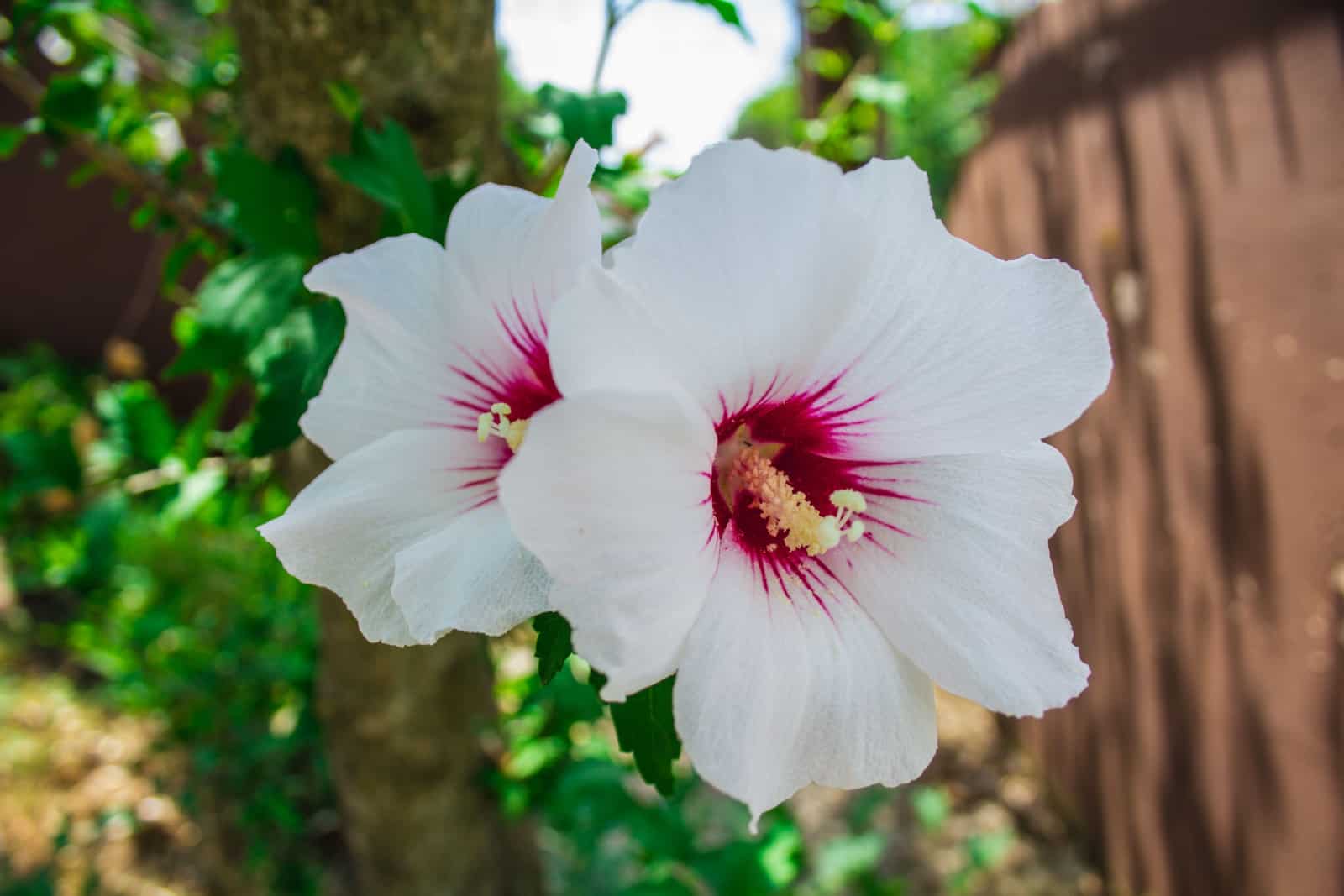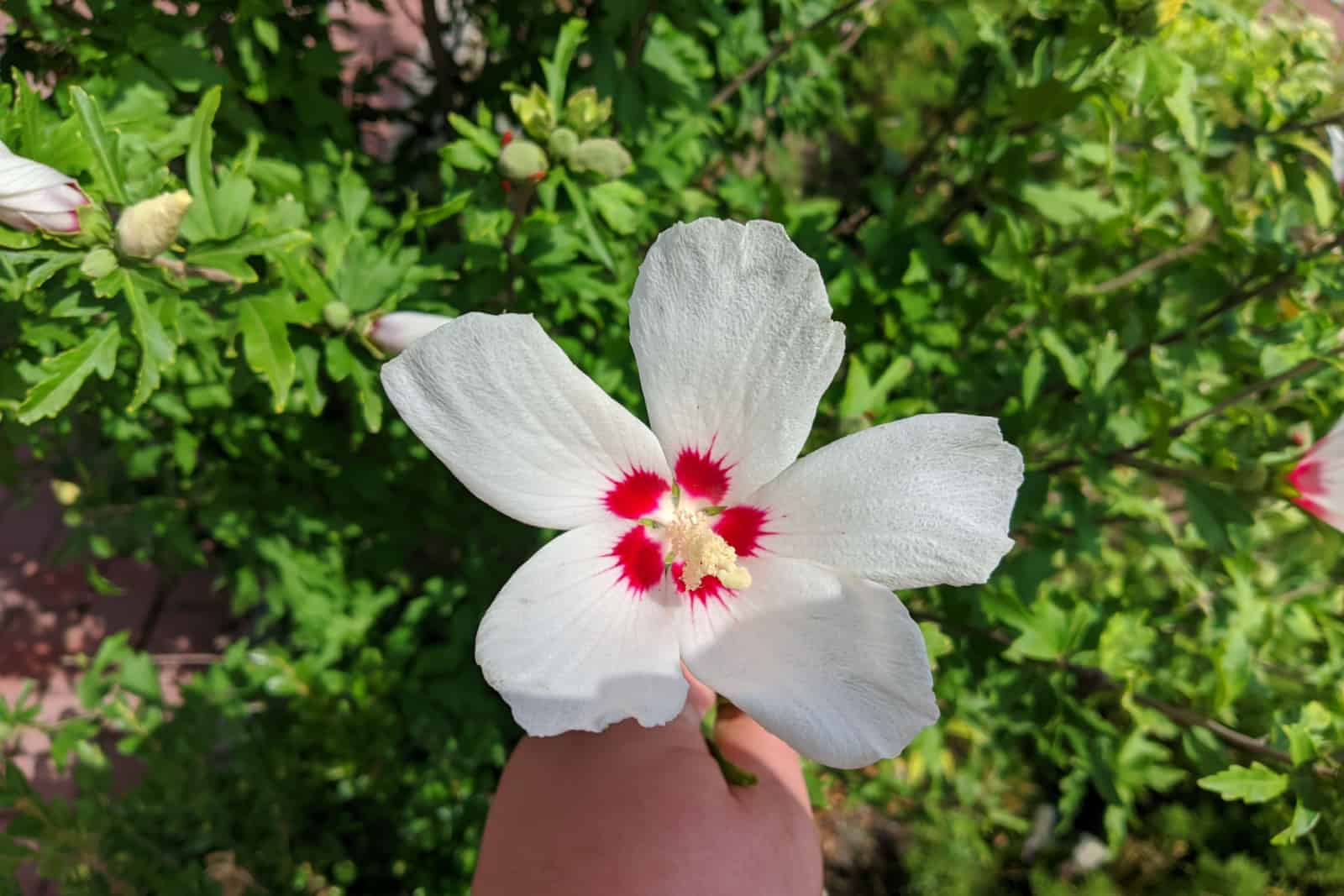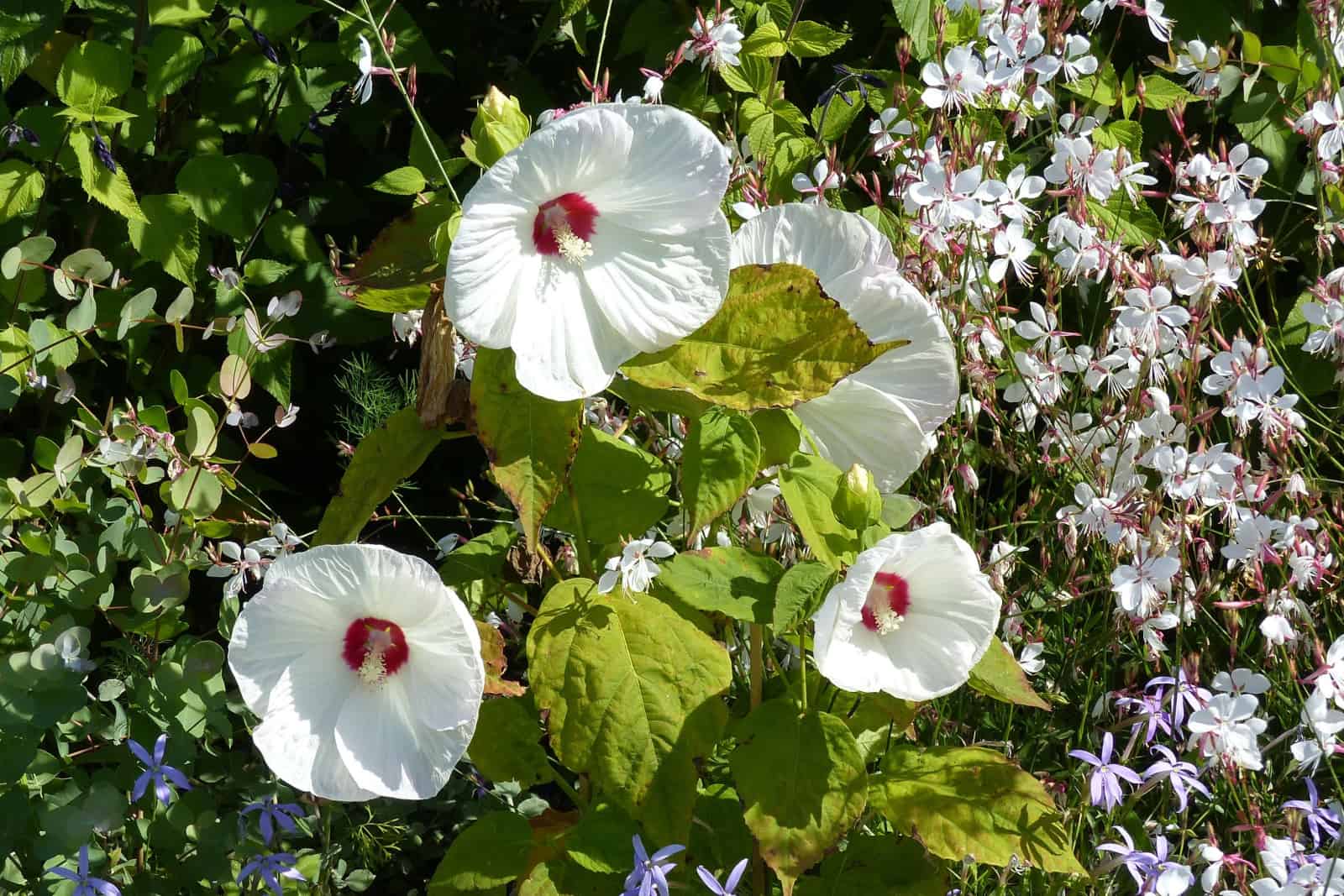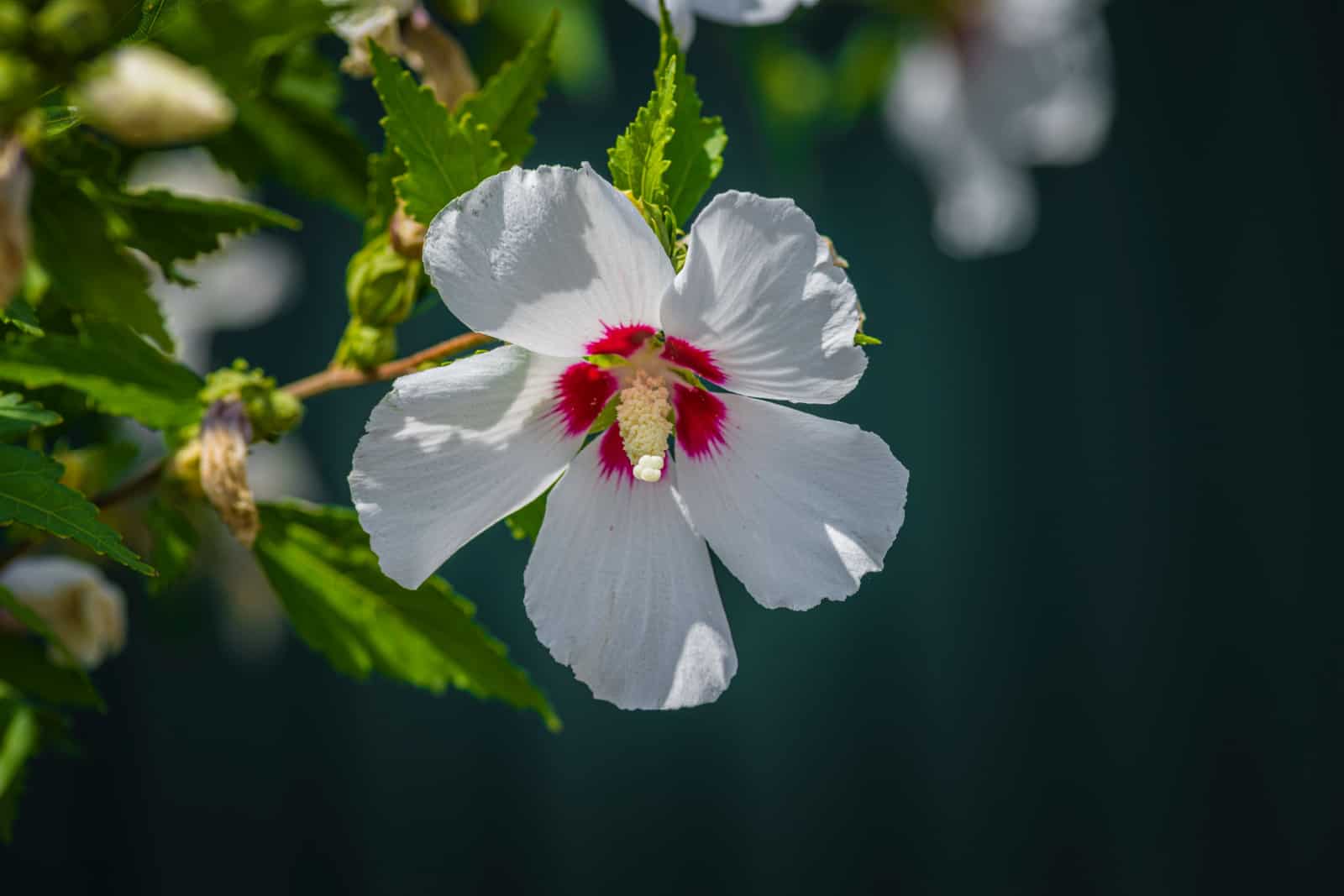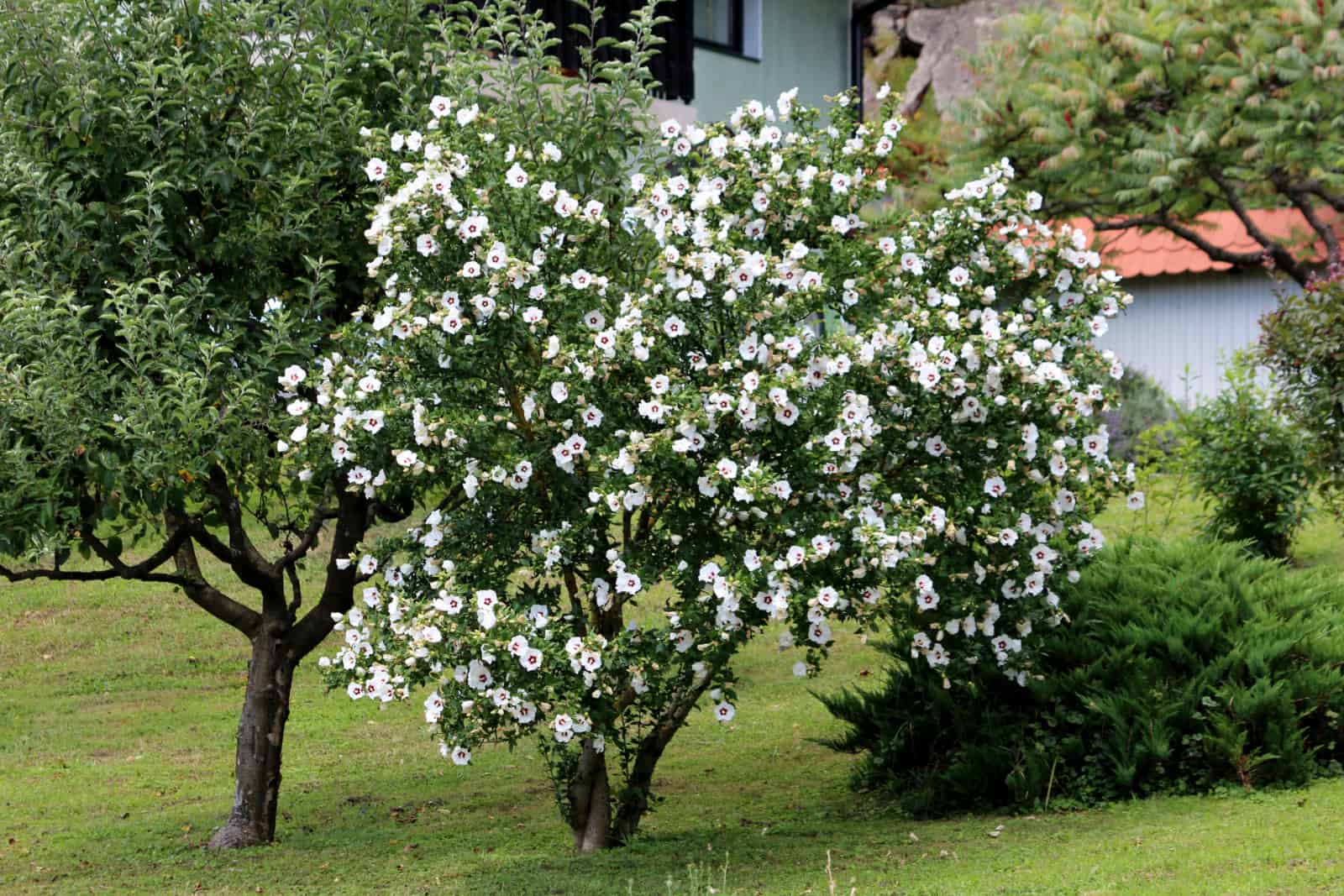Here is yet another lovely hibiscus plant!
The Red Heart hibiscus (botanical name Hibiscus syriacus ‘Red Heart’) is a tropical hibiscus plant that produces white flowers with deep red centers. This hardy shrub is known to be deer-resistant, drought-tolerant, and can also be exposed to full sun.
If you want to have more privacy in your garden, then you should definitely consider growing the Red Heart hibiscus due to its vigorous growth. You can even grow them as hedges!
You can enjoy its beautiful flowers throughout the summer with minimum plant care.
Now, let’s learn some of the plant’s features and how to take care of it.
What Is The Red Heart Hibiscus?
The Red Heart hibiscus is also called the Red Heart Rose of Sharon plant. This lovely perennial deciduous shrub belongs to the Malvaceae family. It produces magnificent flowers and foliage that can make your garden look absolutely dreamy!
With a white flower color and deep red centers, these flowers also have another purpose — they can attract beneficial insects and pollinators like hummingbirds and butterflies.
The bloom time extends from early summer to early fall, so you will get to enjoy and admire these beautiful flowers throughout the entire summer. Young plants also produce flowers, though it will take them some time to reach their mature height, which is around 8 to 10 feet.
They can also spread around 5 feet wide, which is perfect if you want to grow them as a hedge. You have to be careful about the spacing, though. It will probably be fine if you plant them 5 feet away from each other.
Due to their rapid growth rate, you will have a thick and glorious hedge before you know it!
These plants are similar to hydrangeas, so if you are looking for some similar plants, then you should add the Red Heart hibiscus to your wish list. These plants often come in a container, but you can also get them as a dormant bare root.
Red Heart Hibiscus Plant Care Guide
These low-maintenance plants thrive in USDA hardiness zones 5 through 8. You don’t even have to worry about light conditions — just leave them in full sun and they’ll love it!
Other than being extra careful with your watering habits, there aren’t any special plant care requirements that you have to pay close attention to.
So, let’s take a closer look at the Hibiscus plant’s requirements.
Water Requirements
If you have already grown tropical plants, then you are probably aware of their watering needs. These beauties prefer growing in moist soil, which is why you should water them frequently. However, you have to be careful not to overdo it because you might overwater them.
Overwatering is usually accompanied by root rot, which is a deadly fungal disease that can completely ruin your plant.
Getting the right watering schedule can be tricky because other factors affect the watering needs, such as humidity and temperature. I would recommend you always check if the top few inches have dried out before watering the plant again.
If you are growing them outdoors, make sure to water these plants regularly, especially if it hasn’t rained for an extended period of time. A garden hibiscus requires less frequent watering, particularly if it is grown in humid conditions or close to water.
However, if it is too hot outside, you should water the plant every day.
When growing them in pots, make sure that the pot has drainage holes in the bottom so that excess water can drain out easily. Stop adding water to the container as soon as you notice that the water is starting to drain through the potholes.
Ease up with watering during the winter season as these plants enter dormancy, which means they don’t need as much water or nutrients since they are not actively growing.
Soil Requirements
As these plants like to have their soil moist, you will have to provide them with good drainage. This also includes providing them with good soil conditions. In loamy, nutrient-rich, well-drained soil with a pH balance that is just slightly acidic, Red Heart hibiscus plants thrive.
If your soil is excessively dense and solid, you can amend it by adding compost and humus. Additionally, this will add organic matter and raise the fertility of the soil and make it more nutrient-rich. Because they enhance drainage and moisture retention, these materials make excellent soil amendments.
Select high-quality potting soil with enough moisture retention and aeration when growing a hibiscus indoors.
You can even add mulch around the base of these flowering shrubs to help with moisture retention and weed growth prevention.
Light Requirements
We have already mentioned that this plant adores full sun, but it can also tolerate growing in partial shade. However, I would recommend you protect them from too much direct sun exposure during hot summer days.
If you decide to keep them in part shade, make sure that they receive at least 6 hours of bright indirect sunlight a day.
If hibiscus plants are cultivated indoors, they should be near a sunny window so they may take advantage of the morning or afternoon sun.
For instance, you can arrange them close to a window that faces south. To prevent the plant from receiving too much direct sunshine, you could hang some sheer curtains.
Temperature Requirements
Hibiscus plants are quite simple to grow, especially if you are in one of their preferred hardiness zones. Tropical hibiscus varieties can withstand daily lows of 50 degrees Fahrenheit and flourish in ranges of 60 to 85 degrees.
You should consider overwintering them indoors even though they can endure nightly temperatures as low as 20 degrees Fahrenheit, though if they are exposed to such temperatures for a lengthy period of time, it might stunt their growth and cause cold damage.
Humidity Requirements
This cultivar benefits from moderate humidity because it is a tropical plant. Maintain humidity levels between 50% and 70% so your hibiscus plant can flourish. The ideal humidity is simpler to maintain indoors.
For instance, you could buy a humidifier or place your plant in an area with higher humidity levels, such as the kitchen or bathroom. In addition, you can try misting your plant on a daily basis or even create a pebble tray.
Fertilizer Requirements
If you want your hibiscus plant to grow quickly and produce wonderful flowers, you need to fertilize it throughout the growing season. Use a water-soluble liquid fertilizer that has been diluted to at least half-strength to fertilize your potted hibiscus twice a month.
Some growers advise starting to feed these plants once the first hibiscus blossoms begin to fade.
But no matter what you do, stop fertilizing when they are dormant and always give them water after feeding them to help them absorb those nutrients easily.
The best fertilizers would contain a lot of nitrogen and potassium, and low amounts of phosphorus.
Pruning
When new growth first starts to develop in late winter or early spring, it is the ideal time to prune your hibiscus. You can also remove any leaves or other greenery that are dry or dead. Pruning is typically done to maintain the plant’s shape.
It can also be beneficial to encourage new growth by deadheading spent hibiscus blooms and removing any dead, damaged, dry, or aging branches and leaves. As long as you don’t prune more than one-third of the plant, you’ll be good.
Propagation
This plant can be propagated by using stem cuttings or sowing the seeds. Follow the instructions below to successfully propagate your hibiscus plants!
Growing Hibiscus From Seeds
It’s a little trickier to grow hibiscus from seeds than stem cuttings, but it is possible.
1. Before planting, chip the seeds a little and soak them in lukewarm water for about 8 hours.
2. Sow them in a seed starting mixture at a depth of 1/4 inch. Always keep the growing medium moist. To maintain high humidity levels, you can cover it with a humidity dome or a plastic bag with holes in it.
3. Put the nursery tray in a room with good lighting and a temperature of 70 to 75 degrees Fahrenheit. To hasten germination, you can put them on a heating mat.
4. Don’t transplant the seeds just yet. They should start to grow in approximately two to three weeks. As soon as they develop their second set of true leaves, you can consider moving them into a larger container.
Growing Hibiscus From Stem Cuttings
1. Trim away any flower buds and the ends of some robust cuttings. It is also advisable to remove the lower leaves because they could fall off and contaminate the ground below.
2. You should plant your cuttings in a nursery pot filled with seed-starting mixture (any soilless, well-draining medium will do). Although rooting hormone can be applied to cut stems, it is not necessary because this plant can successfully root on its own.
3. Plants ought to be watered and put under dim lighting (or in partial shade if you prefer leaving them outside).
Common Issues With The Red Heart Hibiscus
Although hibiscus plants are relatively easy to grow and take care of, that doesn’t mean you can neglect them completely. The plant will still react to inadequate plant care and pest infestation.
Hibiscus plants are susceptible to pests such as mealybugs, aphids, and whiteflies. These little critters will literally suck the life out of your plants because their primary mission is to steal their juices and nutrients.
They usually reside on the underside of the leaves, and if you notice any leaf discoloration or wilting, immediately inspect the plant for pest infestation.
If you notice that the plant is infected, you should immediately isolate it. Once you’ve isolated your infected hibiscus from your other plants, you can use neem oil or insecticidal soaps to get rid of the pests. Although I usually advise choosing the organic option, you can also use pesticides.
When it comes to plant diseases, the most common are root rot and leaf drop. Overwatering causes root rot, while warm, humid conditions elicit the development of leaf spots. Luckily, these diseases are easily preventable. All you have to do is stick to the plant care guide and try to maintain ideal moisture levels!
Other issues involving inadequate plant care are leaves changing color and the plant wilting. Seeing those magnificent green leaves turn yellow can be devastating. The main reasons leaves turn yellow include a lack of nutrients, excessive watering, root rot, and insufficient light.
Plant wilting is a result of bone-dry soil, especially if the plant is in a location where the temperatures get extremely high.
As soon as you water your plant, it should begin to flourish.
On the other hand, if your plant has root rot or the soil is very damp, it may wilt. In these circumstances, you should refrain from watering the growing medium, inspect the root ball, and remove any afflicted parts, such as mushy roots.
Final Thoughts
The Red heart hibiscus is an ideal plant for gardeners that want to have beautiful flowers in their garden, but not have to spend every free second taking care of the plant.
What’s also great about this plant is that it can be grown as a hedge due to its vigorous growth, but you can also grow it as a single shrub or even grow it indoors in a container — all you have to do is simply prune it to maintain its shape.
Ensure that the plant gets plenty of sunlight, keep the soil moist, and fertilize it to encourage those dreamy flowers to bloom. However, always be on the lookout for those annoying pests that typically invade this plant type, especially if you are growing it outdoors!
Luckily, you can easily get rid of these critters in case of an infestation.
That’s all, folks! I hope this article was helpful.
Until next time!
Like this post? Share or pin it for later!


